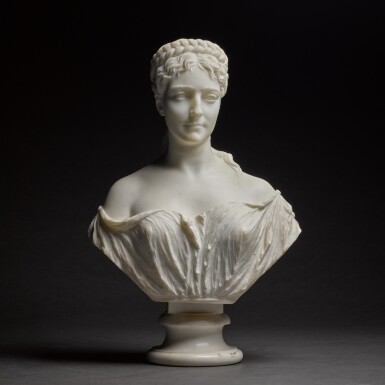
The Property of an Italian Nobleman
PROSPER D' EPINAY | BUST OF ATHENAIS MARIE GRYMES (1832-1897)
Lot Closed
July 9, 03:33 PM GMT
Estimate
40,000 - 60,000 GBP
Lot Details
Description
The Property of an Italian Nobleman
PROSPER D' EPINAY
French
1836 - 1914
BUST OF ATHENAIS MARIE GRYMES (1832-1897)
signed and dated: P. D'Epinay / Roma / 1869
white marble, on a white marble socle
72cm., 28⅜in. overall
Please note: Condition 11 of the Conditions of Business for Buyers (Online Only) is not applicable to this lot.
To view the Shipping Calculator, please click here
Sotheby's London, 26 November 1998, lot 105;
noble collection, Italy
Athenais Marie came from a richly romantic southern American background. Born in New Orleans in 1832 her father, John Randolph Grymes Jr. who was descended from Princess Pocahontas, was a brilliant advocate and advisor to Andrew Jackson during the Battle of New Orleans. He was one of the most highly paid lawyers in the United States, part of his fortune accumulated from fees defending the notorious pirate Jean Lafitte, leader of the Baratarians who operated up and down and Louisiana coast.
Her mother was Suzette Bosque, grand daughter of the last Spanish Governor of New Orleans, who had married as her first husband William Charles Claiborne, the first American governor. Considered a great beauty, she was by reputation ‘the most coquettish, the most charming woman in the city'.
Miss Grymes grew up between Louisiana, Virginia, and her mother's property, Capo di Monte, on Staten Island. Here she met her future husband, Louis Adolphe von Hofmann, a New York banker whose family came from Leipzig. She travelled widely with him in Europe, staying either at their house in Cannes or the Villa Celimontana in Rome, where they moved in the legendary Romano-American literary and artistic circles that included Henry James, and William Wetmore Story, the sculptor working in the classical tradition established by Canova and Thorvaldsen.
The Mauritian-born sculptor Prosper d'Épinay was also working in Rome at that time, after his initial training in Paris, and had moved in 1864 into his sudio in the Via Sistina. From here he sculpted numerous female society portraits displaying his exquisite virtuoso technique of marble carving, which combined classicism with his own particular ability to convey the warmth and sensuality of his sitters particularly through the play of delicately arranged chiffon-thin drapery.
These are truly feminine portraits often with beautifully crafted hair and plaits; examples worth comparing with the present bust are Alexandra, Princess of Wales (1865, British Embassy, Paris, Foujols, op. cit., p. 22); Princess Marie of Baden ( 1869, Foujols, op.cit., p. 24), and Empress Elizabeth of Austria (1870, Foujols, op.cit., p.29). 1869 was also the year of d'Epinay's fine portrait bust of the Spanish painter Mariano Fortuny.
The present marble is one of the most beautiful portrait busts by Prosper d’Épinay to have come onto the market. The quality of the carving is particularly fine in the hair and the marble preserves its original surface.
Prosper d'Épinay was born in Mauritius in 1836, the son of the prominent lawyer and politician, Adrien d'Épinay. In 1857 he moved to Paris to study caricature under the sculptor Jean-Pierre Dantan, and, from 1861, he worked in Rome for Luigi Amici. A British subject, he was active in London during the 1860s and 1870s, and, despite eventually settling in Paris, he continued to exhibit at the Royal Academy in London until as late as 1881.
RELATED LITERATURE
P. Roux Foujols, Prosper d'Épinay (1836-1914): Un mauricien à la cour des princes, Ile Maurice, 1996
